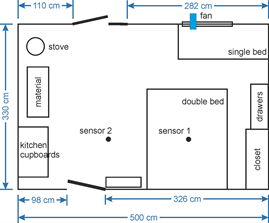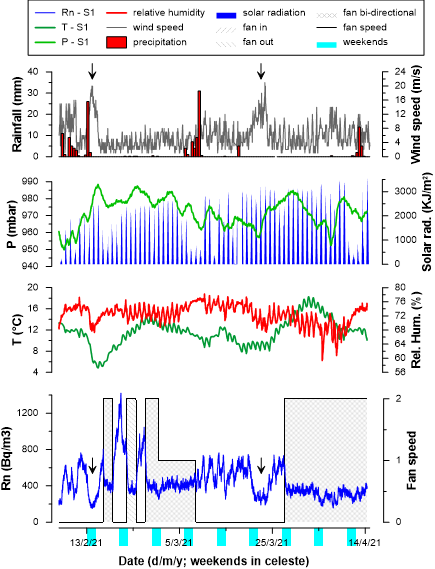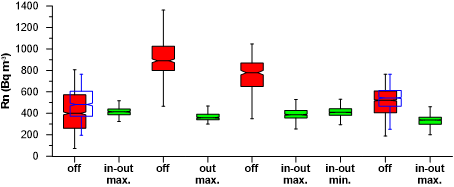R3S test at Bassano Guest House (sperimentation during COVID pandemy) (Action B2)
The travel and access restrictions imposed by the COVID-19 pandemic had an enormous impact on the work planned within the LIFE-Respire project. As the previously installed systems were located in schools that were closed to access, or in homes where the owners were uncomfortable letting external people enter, it became impossible to maintain or substitute them. To overcome this problem during the evaluation of the R3S, new sites were found thanks to personal connections of some researchers involved in the project. This allowed not only for installation, but also for complete cooperation from the home owners in running the experiments and access to the sites if necessary. The very important contribution of these home-owners is gratefully acknowledged. One site is located in Bassano Romano, a town located about 12 km south of Caprarola. in the new 3R system, the ventialtion system is different.
The Bassano Romano site consists of a single-room, ground-floor-only guest house, which is perhaps more representative of living quarters in Italian buildings compared to the basement apartment in Nettuno. Being above ground means that radon is free to migrate both indoors and outdoors, and fan intake can be placed well above ground-level accumulation. Being a single room, however, means that contemporaneous comparison of ventilated and non-ventilated rooms, as was done at Nettuno, is not possible here. The building was not used by the owners during the test period, thus eliminating any uncertainty related to occupant activities (e.g., opening windows or doors). The room measures about 3.3 x 5 x 3.2 m in size (c. 55 m3) and the walls are constructed with volcanic tuffo blocks. It is assumed that the walls are the primary source of indoor radon, where values can reach 1500 Bq m-3. The room contains some furniture and is also used for storage. The room is not heated and the doors and window were kept closed during all tests. The front entrance has a small 1.5m deep porch, while the back door opens onto a 3x3 area having three tuffo walls (one in common with the studied room) and a fourth wall only partially covered with wooden slats.

All monitoring data from the Bassano Romano guest house during the testing of the heat recovery unit are reported in the next fiure. Over the three month period temperature values vary widely, from about 5 to 18°C, due to the fact that the building is not presently being heated. Other atmospheric parameters vary as expected during this late winter, early spring period, with intervals of strong winds being particularly noteworthy (up to 20 m s-1). This figure uses different hatch markings and height of the cure to indicate fan speed (minimum=1, maximum=2). Strong and reproducible impacts were observed on the indoor radon values during the various different tests conducted.

When the fan was left off, values ranged markedly and had different behaviours during different periods, highlighting the influence of meteorological conditions like wind and atmospheric pressure. For example, during the first and fourth “off” periods (i.e., no shading) the maximum values reach around 700 Bq m-3 whereas values as low as about 150 to 200 Bq m-3 are associated with very windy periods (marked with arrows). This is likely caused by wind drawing air up the unobstructed chimney, bringing fresh outdoor air into the room via gaps beneath the doors and from the fan hole. In contrast, the second and third “off” periods do not show such low levels, but instead have values that are typically above 800 Bq m-3 with maximum values as high as 1400 Bq m-3. During all periods when the fan was on, instead, radon values were much more stable and averaged approximately 350 to 400 Bq m-3, clearly indicating the positive impact of the ventilation system. Interestingly, the stable value attained with the fan on tends to be the same regardless of the initial concentration, even when starting at levels near 1000 Bq m-3. This implies a balance between the rate of radon ingress and the flow rate of the fan, as discussed below.
In addition to the temporal Radon plot given in Figure 18, these same results can be divided into the various test periods to assess Rn statistical distributions using box and whisker plots below. This figure clearly shows that when the heat recovery fan was on the radon distribution is lower and narrower (shaded in green) compared to the often much higher and widely dispersed results from the periods when the fan was off (shaded in red). Note that the distributions for more restricted time intervals (which excludes days with anomalously strong winds) is reported for two periods; this results in slightly higher distributions.







